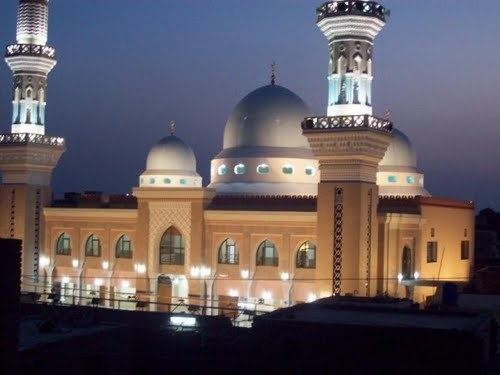Time zone PST (UTC+5) Number of towns 1 Local time Sunday 12:40 AM | Province/state Punjab Calling code 040 Number of union councils 3 Area code 040 | |
 | ||
Weather 16°C, Wind NE at 5 km/h, 51% Humidity Neighborhoods Hassan Town, Cheema Town | ||
Chichawatni (Urdu: چِيچہ وطنى) is a city in the Sahiwal District of the Pakistani province of Punjab. Situated near the Grand Trunk Road, it lies approximately 45 kilometres (28 mi) from the district capital, Sahiwal. In 2011, Chichawatni's population was estimated at approximately 160,000.
Contents
- Map of Chichawatni Pakistan
- Etymology
- History
- Overview
- Forest division
- Cattle market
- Kabbadi stadium
- Educational institutions
- Rail links
- Nearby Villages
- Government investment
- References
Map of Chichawatni, Pakistan
Etymology
There are two leading folk etymologies proposed for the name Chichawatni. The first asserts that the 7th century Raja Dahir named the town Chichawatni – meaning "City of Chach" – for his father, Maharaja Chach of Alor. According to the second etymology, the name is derived from a Hindu family who lived in the area in antiquity, with the father of the family being named Chicha and the mother Watni.
History
From the beginning of the 7th century Rajput Bhatti kingdoms dominated Eastern portions of Pakistan and northern India. In 997 CE, Sultan Mahmud Ghaznavi, took over the Ghaznavid dynasty empire established by his father, Sultan Sebuktegin, In 1005 he conquered the Shahis in Kabul in 1005, and followed it by the conquests of some western Punjab region. Eastern Regions of Punjab from Multan to the Rawalpindi in north (Including region of present-day Faisalabad) remained under Rajput rule until 1193. The Delhi Sultanate and Mughal Empire later ruled the region. The Punjab region became predominantly Muslim due to missionary Sufi saints whose dargahs dot the landscape of Punjab region. After the decline of the Mughal Empire, the Sikh Empire invaded and occupied Sahiwal District. The Muslims faced restrictions during the Sikh rule. During the British Raj, Chichawatni was reputedly transformed from a small Punjabi village into a relatively modern city by infrastructure investment and planning decrees, starting in 1918. At the time of the independence in 1947, many aristocratic Indian Muslim families migrated from Punjab towns like Ludhiana, Jallandhar, Amritsar and Firozpur, and settled in towns like Chichawatni, shaping the city's present-day Muslim elite. The predominantly Muslim population supported Muslim League and Pakistan Movement. After the independence of Pakistan in 1947, the minority Hindus and Sikhs migrated to India while the Muslims refugees from India settled down in the Sahiwal District.
Overview
Chichawatni presently serves as the main city of Sahiwal Division, and is administratively subdivided into three City Union Councils and 34 rural Union Councils. It is also the headquarters of Chichawatni Tehsil. It lies approximately 20 kilometres (12 mi) from the ancient Upper Indus site of Harappa, and is consequently a popular stop-over for tourists. It furthermore serves as the educational hub for many local villages, offering several colleges and institutions for higher education. Punjabi is the most-spoken language in Sahiwal, including Chichawatni, although Urdu is also commonly spoken.
Forest division
Chichawatni is the headquarters of a Pakistani forest division, also named Chichawatni.During The War Of 1857 Local People Fought Against The British In This Forest .In Second World War Many Foreign Prisoners Were Brought Here. Dating to 1923, the Chichawatni Plantation covers a total forested area of approximately 3,600 hectares (9,000 acres), constituting the second-largest forest plantation in Pakistan, the largest being Changa Manga. The Peregrine Fund, a U.S.-based avian conservation organisation, conducted research in Chichawatni's forests in the early 2000s (decade).
Cattle market
Chichawatni's cattle market, known as Mandi Muwaishiyan, is among the largest in Pakistan. Typically, the market runs from the 21st of each month to the end of the month, with its business peaking in three first days.
Kabbadi stadium
Kabbadi – a team sport similar to wrestling – is popular in Chichawatni, which is home to one of the few flood light Kabbadi stadiums in Pakistan. The town has played host to numerous Kabbadi championships.
Educational institutions
Chichawatni is home to numerous institutions of secondary and tertiary education, including:
Rail links
In 1918, Chichawatni's first railway station was constructed, but its position – in the largely impassable forest to the north of the town – made it difficult to reach, despite the expansion of the station in 1927. In July 2007, a new and more accessible railway station was constructed in Chichawatni, with the sanction of then-Prime Minister Zafarullah Jamali.
Nearby Villages
Chichawatni is surrounded by many villages and farming fields. Some of the villages near Chichawatni are Village no.110/12L,Village no.115/12L,Village no.17,Village no.37,Village no.39,village no.45, village no. 108/7.R and lot other villages nearby.
Government investment
In recent years, the Government of Punjab has invested significantly into education in Chichawatni, leading to a rapid increase in the local literacy rate. In partnership with private interests, local authorities have also invested into ICT education, improving the computer skills of school and college students in Chichawatni. Numerous municipal parks and museums have also been constructed with government aid.
